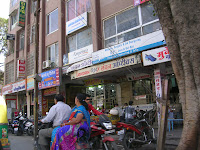Reflections
on my IBM Corporate Service experience in Indore, India
The
need for education in the area of environmental sustainability and smart water
management is dire in most of India and even more so in the dry, hot and dusty
plain where we were - - the city of Indore, in Madhya Predesh, India.
 |
| Sciencetech, green industrialists |
Our
field work took us to several slums, nascent middle class communities, two
prestigious schools and a company where "green" principles are used.
All of the communities we visited rely on water drawn from the aquifer. There
is water that comes to Indore from the Narmada River pipeline but this source
is 70 kilometers away and in demand from many cities in the region.
In
the more organized slums, the community leaders (women mostly) had to prove
that they could maintain a bore well before the municipal corporation would
drill a well for them. Otherwise, the poor and vulnerable communities still
rely on water deliveries from tanker trucks. This is still true in much of
India outside of the biggest cities like New Delhi or Mumbai.
 |
| A woman at Rahul Ghandi Negar |
For
a country that is on the rise in the world economy, it was shocking to see the
lack of infrastructure in India for not only water delivery, but also for basic
sanitation and garbage removal. Pollution of the water ways is another huge
problem. The water we saw was visibly polluted in lakes, rivers and
streams. It is clear that something big
needs to be done to address this problem.
Our
assignment was to provide a Toolkit for the local NGOs and Green Leaders to use
with the citizens of Indore, India. We were asked to provide "Dos and
Don'ts."
Through
our field work we met leaders in different
communities who already know and practice the dos and don'ts. So, our
team, Zack, Maco and me, decided a more meaningful, long term benefit would be
derived from a methodology that stresses changing the mind set, behavior and
capabilities (MB&C) of the citizens. Maco uses these principles in his
consulting work at IBM. It is based on McKinsey Research.
Our
guiding theme was this…
As a society we must acknowledge that
there is no “quick fix” when it comes to addressing water scarcity. The
solution will come with leadership, cooperation and a cultural shift in
thinking about water use and water management.
Part
I of the Toolkit offered a version of MB&C tailored to the Indore citizens
and the NGOs and green leaders who will use is. Part II of the Toolkit provided
practical advice that can be immediately used by individuals, household and/or organizations
for water use and management. Part II
activities range from simply turning off the tap when brushing your teeth and
grey water reuse, to recharging of bore wells, rainwater harvesting and water
treatment.
A
large emphasis of the MB&C is on recognizing and cultivating leadership around
water management. Our recommendation was that the green leaders and NGOs we met
establish a committee, meet regularly and lead the citizenry in the movement
for a sustainable environment and water management in Indore. That they follow
the MB&C program first, so that they can train others.
We
also created a motivational
video produced by the team.
The ending quote from Zarathustra is as poignant today as it was thousands of years
ago when it was written:
God has given us the fire, the air , the
water and the earth – free for our use. We may use them but not abuse them; at
no time defile or pollute them. If we do
so in time Nature will wreak a vengeance and life will become unbearable on
earth.
In
addition to the Green Leaders and NGOs, who work with the vulnerable
communities in the city, we met the most remarkable women in the slums. I refer
to them as water goddesses. Their courage in the face of what we Westerners
consider unimaginable adversity was inspiring. On several occasions we found
ourselves moved to tears.
The
people of Indore were always welcoming
and generous no mater how much or how little they had themselves. I have
fallen in love with them all.
 |
| Indore children |
Our
hope for the city of Indore and for all of India is that leaders will emerge
and flourish in the citizenry, in the government and in the schools and
communities.
For, as I said earlier,
something big needs to be done. Water is life and, life itself is at
stake in India. Water scarcity must be addressed today and everyday.
Namaste,
Maria




















